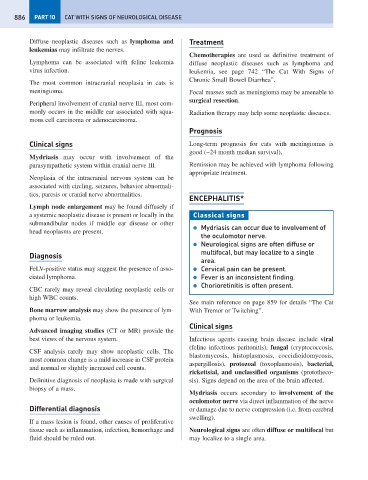Page 894 - Problem-Based Feline Medicine
P. 894
886 PART 10 CAT WITH SIGNS OF NEUROLOGICAL DISEASE
Diffuse neoplastic diseases such as lymphoma and Treatment
leukemias may infiltrate the nerves.
Chemotherapies are used as definitive treatment of
Lymphoma can be associated with feline leukemia diffuse neoplastic diseases such as lymphoma and
virus infection. leukemia, see page 742 “The Cat With Signs of
Chronic Small Bowel Diarrhea”.
The most common intracranial neoplasia in cats is
meningioma. Focal masses such as meningioma may be amenable to
surgical resection.
Peripheral involvement of cranial nerve III, most com-
monly occurs in the middle ear associated with squa- Radiation therapy may help some neoplastic diseases.
mous cell carcinoma or adenocarcinoma.
Prognosis
Clinical signs Long-term prognosis for cats with meningiomas is
good (~24 month median survival).
Mydriasis may occur with involvement of the
parasympathetic system within cranial nerve III. Remission may be achieved with lymphoma following
appropriate treatment.
Neoplasia of the intracranial nervous system can be
associated with circling, seizures, behavior abnormali-
ties, paresis or cranial nerve abnormalities.
ENCEPHALITIS*
Lymph node enlargement may be found diffusely if
a systemic neoplastic disease is present or locally in the Classical signs
submandibular nodes if middle ear disease or other
● Mydriasis can occur due to involvement of
head neoplasms are present.
the oculomotor nerve.
● Neurological signs are often diffuse or
multifocal, but may localize to a single
Diagnosis
area.
FeLV-positive status may suggest the presence of asso- ● Cervical pain can be present.
ciated lymphoma. ● Fever is an inconsistent finding.
● Chorioretinitis is often present.
CBC rarely may reveal circulating neoplastic cells or
high WBC counts.
See main reference on page 859 for details “The Cat
Bone marrow analysis may show the presence of lym- With Tremor or Twitching”.
phoma or leukemia.
Clinical signs
Advanced imaging studies (CT or MR) provide the
best views of the nervous system. Infectious agents causing brain disease include viral
(feline infectious peritonitis), fungal (cryptococcosis,
CSF analysis rarely may show neoplastic cells. The
blastomycosis, histoplasmosis, coccidioidomycosis,
most common change is a mild increase in CSF protein
aspergillosis), protozoal (toxoplasmosis), bacterial,
and normal or slightly increased cell counts.
rickettsial, and unclassified organisms (prototheco-
Definitive diagnosis of neoplasia is made with surgical sis). Signs depend on the area of the brain affected.
biopsy of a mass.
Mydriasis occurs secondary to involvement of the
oculomotor nerve via direct inflammation of the nerve
Differential diagnosis or damage due to nerve compression (i.e. from cerebral
swelling).
If a mass lesion is found, other causes of proliferative
tissue such as inflammation, infection, hemorrhage and Neurological signs are often diffuse or multifocal but
fluid should be ruled out. may localize to a single area.

